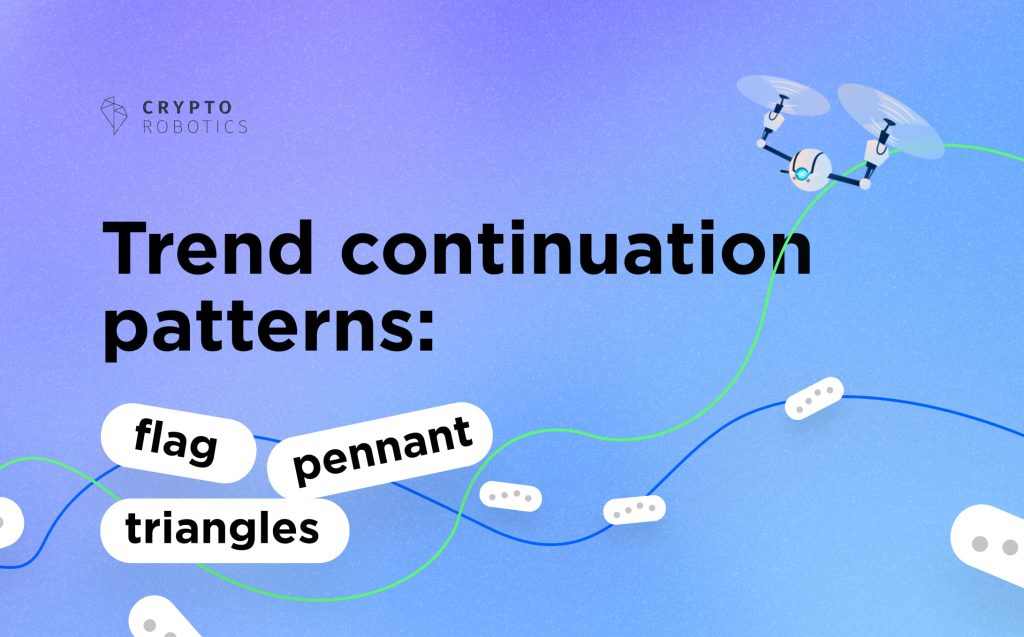Exploring Trend Continuation Patterns: Flags, Pennants, and Triangles in Trading Analysis

Cryptocurrency markets, due to their high volatility and unique characteristics, provide traders and investors with unique opportunities for profitable trading. In such a dynamic environment, technical analysis becomes especially crucial—a powerful tool that allows the analysis of past price movements and the prediction of potential trends.
In the search for key indicators and signals in financial markets, traders pay attention to geometric patterns that significantly influence price dynamics. Among such patterns, flags, pennants, and triangles stand out as three important elements of technical analysis. These patterns serve as reliable indicators of trend continuation. In this article, we will delve deeper into the analysis of these geometric formations, their practical application, and their role in shaping trading strategies.
Flag: Formation and Interpretation in Cryptocurrency Trading
In technical analysis of financial markets, a flag is a pattern that occurs after a sharp price movement in a specific direction, representing a short-term pause or correction before a potential continuation of the current trend. The flag has a distinctive rectangular shape formed by parallel support and resistance lines.
Key characteristics of a flag include:
- Direction: Flags can be bearish (descending) or bullish (ascending), depending on the preceding trend.
- Duration: Typically, a flag represents a short period ranging from a few days to a few weeks.
- Trading Volume: Trading volume often decreases during the flag formation and increases upon its breakout.
A flag signals that the market is preparing for a new impulsive movement in the direction of the previous trend. Traders use flags to identify potential entry points and determine target price levels. Confirmation of the flag breakout is a crucial aspect, emphasizing the potential change in price dynamics and supporting the trader’s forecasts.
How is a Flag Formed?
When a flag is forming, it is crucial to anticipate a channel breakout in the direction of the ongoing trend. In the case of a bullish flag, a breakthrough of resistance signals a potential continuation of the pattern. Thus, entering a position can be executed on the breakout or retest of the resistance level. For a bearish flag, on the contrary, one should expect a breakout of the lower channel boundary, serving as a signal to enter a short position. An effective moment to open a short position is the breakout or retest of the support level.
For risk management, a prudent approach involves setting a stop-loss at the upper and lower boundaries of the channel for bearish and bullish flags, respectively. Additionally, to minimize losses, placing a stop order near the breakout boundary is an option, although it may increase the risk of position closure in the event of a sudden price change.
Pennant
In technical analysis of financial markets, a pennant is a pattern that is a variation of a flag and occurs after a sharp price movement. A pennant is also a short-term correction but differs in its triangular or flag-like shape. This pattern is considered a continuation of the previous trend.
Key characteristics of a pennant include:
- Direction: A pennant can be bearish (descending) or bullish (ascending), depending on the preceding trend.
- Shape: A pennant has a triangular form, where support and resistance lines converge, forming a cone-like structure.
- Duration: Pennants are typically characterized by a relatively short time frame, ranging from a few days to a few weeks.
Traders and analysts use pennants to identify future directions of price movements. Like with flags, the breakout of a pennant is crucial for traders, as it may indicate a potential resumption of the trend. These moments can be used to make decisions about entering the market and managing risks.
How is a Pennant Formed?
When a pennant is forming, it is advisable to open a position upon the breakout of the channel boundaries in the direction of the current trend. A buy order can also be placed after the breakout, waiting for a retest of the channel boundary. For instance, if a pennant is forming after an upward movement, an expected breakout of the channel in the direction of the continued upward trend is anticipated. It is prudent to wait for the breakout of the upper boundary of the pattern before entering a position. In this case, a stop order can be set either below the resistance level or at the lower boundary of the narrowing channel.
It is important to note that both flags and pennants form after sharp price changes in the asset and with a decrease in trading volumes. The price movement after the breakout of the pattern depends on the intensity of the preceding movement. These patterns can occur on various timeframes and often attract the attention of intraday traders.
For risk management, setting a take-profit level at 60-80% of the “flagpole” height, i.e., the height of the preceding price movement, can be considered. Placing a stop-loss in the middle of the channel is another approach to reduce potential losses in case of price movement in the opposite direction. It is crucial to use additional indicators to confirm signals before making trading decisions.
Pennants have several variations and also indicate a continuation of the previous trend. Symmetrical, ascending, and descending triangles are simple geometric shapes widely used for trading and analyzing future market movements.
Triangles: Symmetrical, Ascending, and Descending
In technical analysis of financial markets, triangles are graphical patterns formed by support and resistance lines converging to create a triangular formation. These patterns are essential tools for traders and investors as they can predict future price movements.
There are three main types of triangles:
Symmetrical Triangle
A symmetrical triangle in technical analysis is a graphical pattern that forms when two lines, representing the upper resistance boundary and lower support boundary, converge to create a triangular formation. This triangle earns its name because both of its boundaries are symmetrical, converging towards the central point, forming an angle.
Key characteristics of a symmetrical triangle:
- Shape: A symmetrical triangle has a symmetrical structure where the upper and lower lines converge toward each other.
- Resistance and Support Lines: The upper line represents the resistance level, while the lower line represents the support level.
- Convergence of Lines: Resistance and support lines converge at the central point, creating a triangular formation.
- Trading Volume: Trading volume typically decreases as the triangle approaches its end and increases upon its breakout.
The symmetrical triangle is often considered a continuation pattern of the current trend, whether it is upward or downward. Traders anticipate a breakout of the upper or lower boundary of the triangle, signaling a potential future price movement. The size of the triangle (height from upper to lower line) can be used to determine a potential target after the breakout.
Symmetrical triangles often attract the attention of traders and investors as indicators of possible changes in market dynamics. They can be used in conjunction with other indicators to make decisions about entering a trade, setting stop-loss orders, and determining targets when trading in financial markets.
Ascending Triangle
An ascending triangle in technical analysis is a graphical pattern formed when the upper resistance boundary is horizontal, and the lower support boundary forms higher lows. This pattern creates a triangular structure where the upper line serves as a resistance level that remains relatively constant, while the lower line forms higher lows.
Key characteristics of an ascending triangle:
- Horizontal Upper Boundary: The upper line of the triangle remains horizontal and acts as a resistance level.
- Support with Higher Lows: The lower line forms higher lows, indicating a gradual strengthening of buying activity.
- Volume Contraction: Trading volume often decreases as the triangle approaches its end.
- Trend Continuation: The ascending triangle is considered a pattern of continuing the current upward trend.
Traders anticipate a breakout of the upper boundary of the triangle, signaling further strengthening of the upward trend. The height of the triangle (distance from upper to lower line) can be used to estimate a potential target after the breakout. Typically, trading volume increases upon breaking the upper boundary.
An ascending triangle signals that the upward trend may continue, especially upon breaking the upper boundary. Like all graphical patterns, it is essential to use the ascending triangle in conjunction with other indicators and analyses to make more informed trading decisions.
Descending Triangle
A descending triangle in technical analysis is a graphical pattern formed when the upper resistance boundary is horizontal, and the lower support boundary forms lower highs. This pattern creates a triangular structure where the upper line serves as a resistance level that remains relatively constant, while the lower line forms lower highs.
Key characteristics of a descending triangle:
- Horizontal Upper Boundary: The upper line of the triangle remains horizontal and acts as a resistance level.
- Support with Lower Highs: The lower line forms lower highs, indicating a gradual strengthening of selling activity.
- Volume Contraction: Trading volume often decreases as the triangle approaches its end.
- Trend Continuation: The descending triangle is considered a pattern of continuing the current downward trend.
Traders anticipate a breakout of the lower boundary of the triangle, signaling further strengthening of the downward trend. The height of the triangle (distance from upper to lower line) can be used to estimate a potential target after the breakout. Trading volume usually increases upon breaking the lower boundary.
A descending triangle signals that the downward trend may continue, especially upon breaking the lower boundary. Like other graphical patterns, it is important to use the descending triangle in conjunction with other indicators and analysis for more reasoned trading decisions.
Trading Signals and Risk Management:
- Entry: Traders may consider entering a position upon the breakout of the triangle boundary, expecting confirmation of the trend continuation.
- Stop-Loss: Setting a stop-loss is often done beyond the triangle to minimize potential losses.
- Take-Profit: The height of the triangle can be used to determine the target level when closing a position.
- It is important to remember that triangles can form on various timeframes, and it is advisable to use them in conjunction with other indicators and analytical methods when making decisions.
How to Start Using Trend Continuation Patterns on the Cryptorobotics Platform?
- Go through the registration process on the Cryptorobotics platform if you haven’t done so already.
- Familiarize yourself with the platform interface, including price charts, indicators, and technical analysis tools.
- Choose the cryptocurrency asset on which you want to apply trend continuation patterns.
- Add relevant indicators to the chart to display trend continuation patterns.
- Analyze the charts and use technical analysis to identify trend continuation patterns.
- Make decisions about entering or exiting trades based on the signals provided by these patterns.
- Set stop-loss and take-profit levels for effective risk management.
- Start trading cryptocurrencies.
Remember that cryptocurrency trading always involves risks, so it is important to be cautious and use a sensible approach to capital management.



